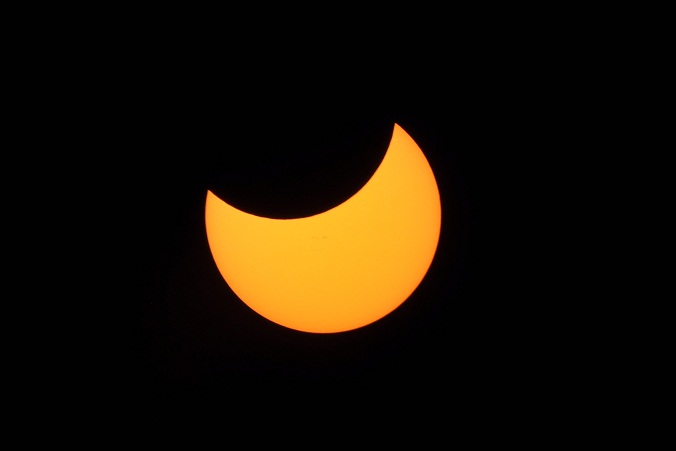The Ilan Ramon Center at Ben-Gurion University operated dozens of teams of students who explained to the general public while observing the solar eclipse, while observations along the line of Mashdod and north were canceled due to the weather

The solar eclipse during which the moon covered almost half of the sun was science fiction for most Israelis. From the Ashdod line and to the north, heavy clouds covered the sky. In the Tel Aviv area, it rained in the morning, so that the damaged sun was also hidden.
Those who benefited from the no-man's land were the residents of the Negev from Ashkelon to Beer-Sheva and south, who could choose from dozens of observation points organized by the Ilan Ramon Center for Youth Seeking Physics at Ben Gurion University.
In a conversation with the science site Netzah Parbiash - director of the field of astronomy at the Ilan Ramon Center - explains. Because the center was established by the Rashi Foundation and is jointly owned by the foundation, the university, the Ministry of Education, the municipality of Beer Sheva, Madaram, and is managed by Beit Tezif.
"As part of the normal annual activity, the center operates a huge amount of students - 20-30 thousand from kindergartens to between 5-7 visits including advanced training for kindergarteners, astronomy activity), 2,500 elementary school students, middle schools and high schools/
"One of the most important programs is called a program for scientific leadership. As part of this program, selected high school students are located and trained to mentor elementary school students for three years. In addition, they help us and actually lead scientific and educational activities for the community such as the science festival and special activities as they were today during the solar eclipse."
Where did observations take place?
"In total, many thousands came today to watch the eclipse. The settlements where a scientific activity took place, including an in-depth scientific explanation and observation of the eclipse, are Ashkelon, Ofakim, Merhavim, Netivot, Eshel Hanasi, Beer Sheva, Omer, Arad, Dimona, the students of the Bedouin diaspora also came to a special activity in Beer Sheva. There are other settlements where we planned to make observations such as Ashdod, Kiryat Gat and Kiryat Malachi, but there it did not come to fruition due to the weather. It is about thousands of people who joined and witnessed this wonder, a tremendous celebration of science."
In addition, the Ilan Ramon Center has activities in kindergartens, elementary schools, high schools, and there was a research activity at the Ilan Ramon Center. The student house at Ben Gurion University in which hundreds of people participated, and where we opened ETX telescopes with solar filters, dozens of eclipse glasses that we purchased especially for the event, and the youth from the scientific leadership program provided amazing explanations.

5 תגובות
During the eclipse I aimed the telescope at the sun using the finder (which of course also had a filter). But after I finished aiming I covered the front eyepiece of the filter with plastic and distractedly took off the filter and only after a few seconds I covered it with its cap... for a few seconds there was almost a hole in the front eyepiece cap (and that's only with a 50mm lens). That's what concentrated sunlight does. A fire (just like we did experiments with a magnifying glass)… we usually have no reason to look at the sun. In the eclipse there is a reason to look. The danger is just as great. And even in an almost total eclipse, the sunlight that remains is strong enough. The special glasses are good for every day of the year even though there is not much to see (orange circle)…
Another warning… under no circumstances use glasses and then look through binoculars… the filter must be the first thing…
As far as I know, the answer is yes - it's always good to look at the sun only through a filter.
Peace,
Are the special glasses I bought for viewing the eclipse; Can be used to view the sun even without impairment.
Thanks
Viewing a solar eclipse opens up possibilities for a higher penetration of radiation - and because there are no nerves in the cornea, when it burns you will not feel anything.
Pity your beautiful eyes.
In addition, I would like to speculate that with all the switches for the 125-ETX, the CORNADO PST was also used, which is a telescope designed for observing the sun.
Can I get an explanation please why viewing the solar eclipse is dangerous?
Is the danger special because of the solar eclipse or is the danger always present when looking towards the sun and only the solar eclipse event attracts people to look at the sun?